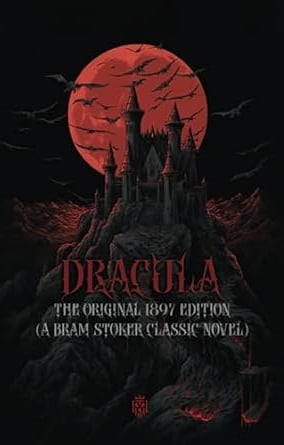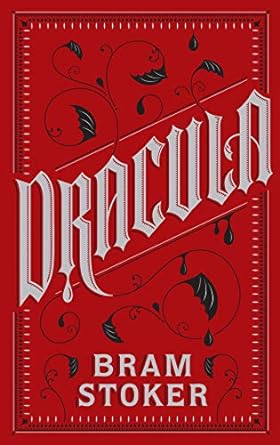Dracula Meaning & Ending
Jump to Ending Explained, Novel Meaning, or Ending Adaptations for Dracula.
We also have chapter summaries and more study resources here.
Dracula Ending Explained
Explain the ending of Bram Stoker's novel Dracula
In the ending of Bram Stoker's Dracula, the group of main characters — Jonathan Harker, Mina Harker, Professor Van Helsing, Dr. John Seward, Lord Godalming (Arthur Holmwood), and Quincey Morris — converge on Count Dracula's castle in Transylvania in an attempt to finally put an end to the vampire's reign of terror.
Here's a brief rundown of the climax and conclusion:
The Pursuit: The group pursues Dracula, who is fleeing back to his castle in Transylvania. They divide into two parties to trap him. Dracula's coffin, which he needs to rest in, is transported by Gypsies.
The Final Confrontation: As they approach the castle, the group encounters the Gypsies transporting Dracula and a fight ensues. Jonathan Harker and Quincey Morris manage to break through to the wagon carrying Dracula's coffin.
Dracula's Death: Harker slashes at Dracula with a kukri knife while Morris stabs him in the heart. Dracula crumbles to dust, signaling his death and end of his curse.
Sacrifice: The victory, however, comes at a cost. Quincey Morris is mortally wounded in the confrontation and dies. In his honor, Mina and Jonathan name their son after him.
Epilogue: The novel ends with an epilogue written by Jonathan Harker, dated seven years after the events. It notes that the surviving members of the group gather annually to honor the memory of their friend Quincey Morris. Jonathan and Mina have a son, named Quincey. The scars on Mina's forehead from Dracula's bite have faded, symbolizing the end of the trauma. Dracula's castle remains standing but is deserted and falling into ruin.
The conclusion serves as a resolution to the intense, globe-spanning hunt for Dracula and the terror he inflicted. While the vampire is defeated, the costs of the battle, both emotional and physical, linger on for the characters, and the memory of the events and the sacrifices made remains with them.
Dracula Novel Meaning
Explain the meaning of Bram Stoker's novel Dracula
Bram Stoker's Dracula is not just a tale of supernatural horror; it's a complex narrative layered with themes and meanings that have been analyzed and interpreted in various ways since its publication. Here are some key interpretations and themes present in the novel:
Fear of the Unknown: The novel, through its portrayal of Count Dracula as a foreign, otherworldly threat coming from Eastern Europe to England, touches on fears of the unknown and the outsider. This can be viewed as a reflection of Victorian anxieties about invasion and the dissolution of the British Empire.
Sexuality: The novel often delves into issues of sexuality, especially in the Victorian context. The vampire bite can be seen as a metaphor for sexual relations, with Dracula's bite representing a more aggressive, taboo form of sexuality compared to the more restrained Victorian norms. The female characters, particularly Lucy, experience transformations in their behavior and desires after being bitten, which can be read as commentary on Victorian fears of female sexuality.
Science vs. Superstition: The character of Dr. John Seward, who runs a mental institution, represents the emerging faith in science and rationality in the Victorian era. However, he and his contemporaries are ill-equipped to deal with the supernatural threat of Dracula until they embrace older, more superstitious methods, primarily through the knowledge of Professor Van Helsing. The novel thus delves into the tension between modern science and traditional beliefs.
Degeneration Theory: The late 19th century saw concerns about degeneration, the idea that instead of progressing, society (and individuals within it) might be in decline. Dracula, with his ancient, predatory nature, can be seen as a symbol of degeneration, threatening to infect the modern world with primitive and destructive tendencies.
Disease and Contamination: The act of vampirism can be likened to the spread of contagious diseases. This theme resonated with Victorian readers who were dealing with fears related to outbreaks and the transmission of illnesses. Dracula's invasion of England and his intent to spread vampirism can be seen as an allegory for a pandemic.
Colonialism and Imperial Anxiety: Dracula's journey from Transylvania to England can be interpreted in the context of imperial anxieties. The British Empire, which had colonized many parts of the world, now faced a reversal as Dracula, a foreign entity, sought to invade and colonize Britain.
Duality of Human Nature: Throughout the novel, characters exhibit dual natures or are transformed from their original states (like Lucy's transformation into a vampire). This theme is consistent with other literature of the period, notably Robert Louis Stevenson's The Strange Case of Dr Jekyll and Mr Hyde, and suggests a Victorian fascination with the duality of human nature.
While Dracula can be enjoyed as a thrilling horror story, its depth and the many themes it touches upon have made it a subject of study and interpretation for over a century. It encapsulates many anxieties and curiosities of the Victorian age while still resonating with readers today.
Endings in Dracula Adaptations
Are there any Dracula adaptations that change the ending?
Yes, there have been numerous adaptations of Bram Stoke's Dracula over the years, and many have taken liberties with the story, including the ending. Here are a few notable adaptations with alternate endings or significant deviations:
Nosferatu (1922): This silent film, directed by F.W. Murnau, is an unauthorized adaptation of Dracula. In this version, the vampire, renamed Count Orlok, is destroyed by sunlight when he's lured into staying up until dawn by Ellen, a character analogous to Mina.
Dracula (1931): In the classic Universal film starring Bela Lugosi, Dracula is pursued to his lair by Professor Van Helsing. Instead of the large confrontation from the novel, Van Helsing stakes Dracula off-screen, and the movie concludes with Mina saved from the vampire's influence.
Bram Stoker's Dracula (1992): Directed by Francis Ford Coppola, this adaptation includes a romantic subplot between Mina and Dracula, suggesting she's the reincarnation of Dracula's lost love. In the end, after a confrontation in the castle, Mina kills Dracula out of love, releasing him from his curse.
Dracula 2000: In this modern reimagining, Dracula is revealed to be Judas Iscariot, the biblical figure who betrayed Jesus. The ending involves a confrontation in which Dracula is hung with a silver noose, echoing Judas's own fate.
BBC's Dracula (2020): In this recent adaptation, the ending is vastly different. Dracula and Sister Agatha (a modern reinterpretation of Van Helsing) confront each other in the final episode. The conclusion delves into Dracula's fears and the nature of death.
These are just a few examples among countless adaptations, reimaginings, parodies, and sequels in various media forms. Dracula's story, being part of the public domain, has allowed for an immense variety of interpretations and changes.
Support Ai Read to Me
Help us create more audiobooks and release more free content! Shop our store, or purchase anything on Amazon via the book affiliate links below.
We are very grateful for your support!







